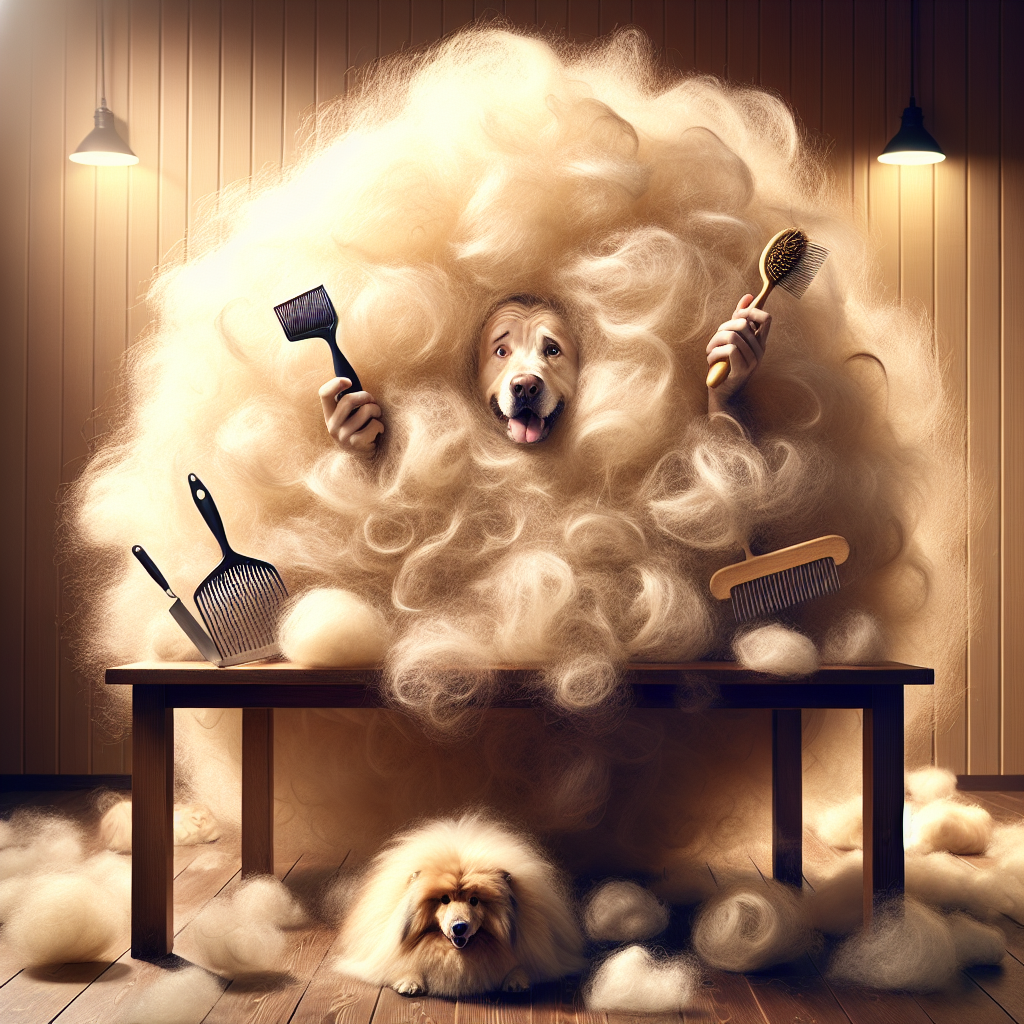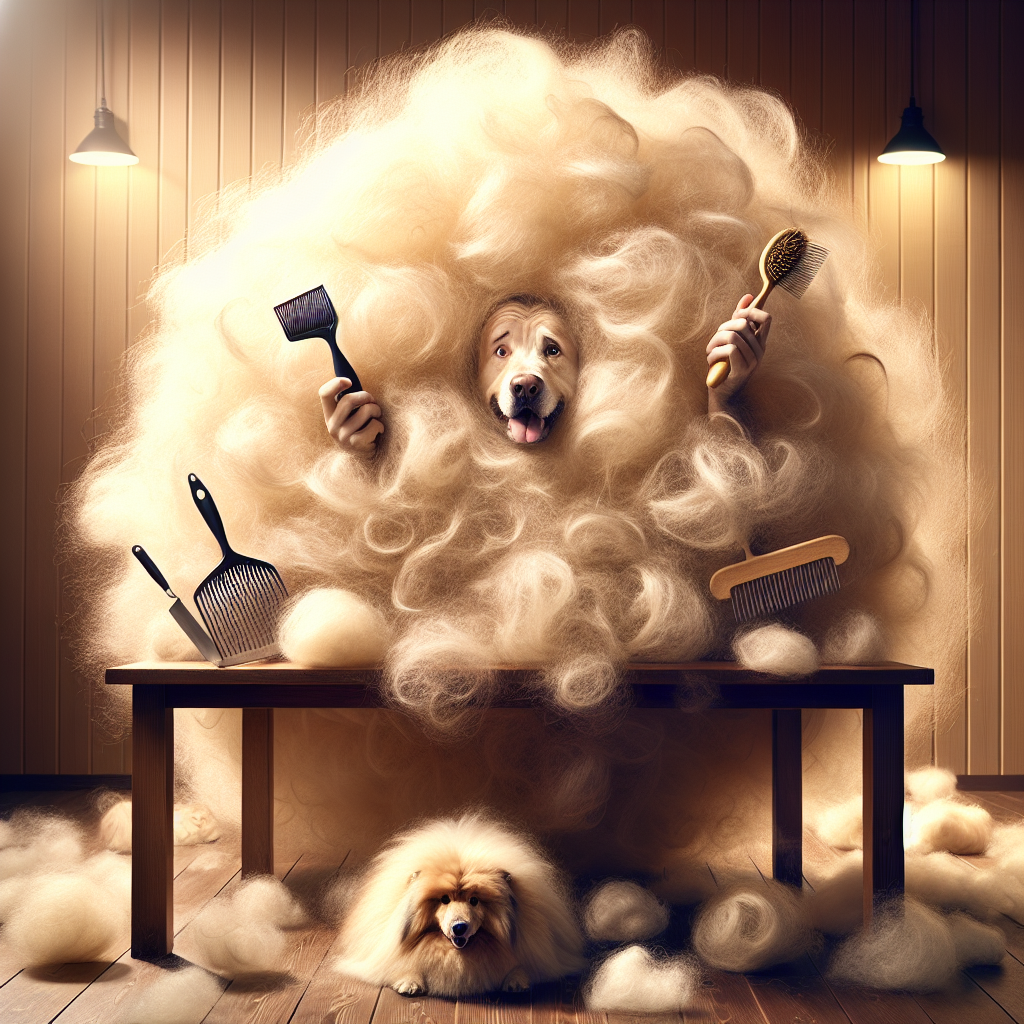If you’re a dog owner, chances are you’ve experienced the never-ending struggle of dealing with shedding. Those stray hairs that seem to stick to everything you own can be quite a nuisance. But fear not, because in this article, you’ll discover some helpful tips and tricks on how to tackle shedding in dogs. From regular brushing routines to a proper diet and grooming techniques, we’ll provide you with all the practical advice you need to keep your furry friend’s shedding under control and your home hair-free. So say goodbye to those pesky dog hairs and say hello to a cleaner, happier living space for both you and your four-legged companion.

Understanding Shedding in Dogs
Shedding is a natural process in dogs where they lose their old or damaged hair to make room for new hair growth. While shedding is a normal occurrence, excessive shedding can be a cause for concern. Understanding the causes of shedding, different coat types, and health conditions that can contribute to excessive shedding is important for effectively managing this issue.
Causes of Shedding
There are several factors that can contribute to shedding in dogs. One of the main causes is seasonal changes, as many dogs tend to shed more during the spring and fall when they are transitioning between their winter and summer coats. Hormonal changes, such as those related to pregnancy or heat cycles, can also trigger increased shedding. Additionally, some medical conditions, nutritional deficiencies, stress, and anxiety can contribute to excessive shedding.
Normal Shedding vs. Excessive Shedding
It is important to distinguish between normal shedding and excessive shedding in dogs. Normal shedding occurs throughout the year, but the amount can vary depending on the breed and individual dog. Excessive shedding, on the other hand, is characterized by an abnormally large amount of hair loss that goes beyond the normal shedding cycle. If you notice clumps of hair coming out or bald patches on your dog’s skin, it may be a sign of excessive shedding that requires attention.
Different Coat Types
Understanding your dog’s coat type is crucial for managing shedding. Dogs can have a variety of coat types, including short, medium, long, curly, or wiry. Each coat type requires different grooming techniques and tools. For example, dogs with short coats may require less maintenance and shedding control compared to those with long or curly coats.
Health Conditions that Cause Excessive Shedding
Certain health conditions can contribute to excessive shedding in dogs. Hormonal imbalances, such as hypothyroidism or Cushing’s disease, can disrupt the normal hair growth cycle and lead to increased shedding. Skin allergies, infections, and parasites like fleas or mites can also cause excessive shedding. If your dog is experiencing excessive shedding along with other concerning symptoms like itching, redness, or hair loss, it is important to consult a veterinarian for a proper diagnosis and treatment.
Preventive Measures
Taking preventive measures can help reduce shedding and keep your dog’s coat healthy and shiny. Here are some effective preventive measures to consider:
Regular Grooming
Regular grooming is essential for managing shedding in dogs. Brushing your dog’s coat helps remove loose hair and prevent it from spreading around your home. The frequency of brushing depends on your dog’s coat type and length. Dogs with longer or thicker coats may require daily brushing, while those with shorter coats may only need brushing a few times a week.
Proper Nutrition
A balanced and nutritious diet is crucial for maintaining a healthy coat and minimizing shedding. Ensure that your dog’s food contains high-quality ingredients and provides the necessary nutrients for healthy skin and coat. Look for dog food formulas that are specifically tailored to promote coat health, such as those enriched with essential fatty acids, vitamins, and minerals.
Hygiene and Cleaning
Maintaining good hygiene and cleanliness in your dog’s environment can help reduce shedding. Regularly cleaning your dog’s bedding, vacuuming your home, and removing loose hair from furniture can prevent excessive shedding in the house. Additionally, keeping your dog clean by bathing them regularly with a gentle shampoo can help remove loose hair and reduce shedding.
Managing Stress and Anxiety
Stress and anxiety can contribute to excessive shedding in dogs. Creating a calm and comfortable environment for your dog can help minimize stress and reduce shedding. Provide them with appropriate outlets for mental and physical stimulation, such as regular exercise, interactive toys, and a peaceful space where they can relax and unwind.
Choosing the Right Tools and Products
Using the right grooming tools and products is essential for effectively managing shedding in dogs. Here are some tools and products that can help:
Brushes and Combs
Choosing the right brush or comb for your dog’s coat type is crucial. Slicker brushes are great for removing loose hair from dogs with medium to long coats, while bristle brushes work well for short-haired breeds. For dogs with curly or wiry coats, a comb with wide-spaced teeth can effectively remove tangles and prevent matting.
Shampoos and Conditioners
Using the right shampoo and conditioner can help maintain a healthy coat and reduce shedding. Look for gentle and moisturizing formulas that are specifically designed for dogs. Avoid using human shampoos, as they can strip the natural oils from your dog’s coat and potentially irritate their skin.
Furminators and Deshedding Tools
Furminators and deshedding tools can be highly effective in removing loose hair from your dog’s undercoat. These tools have specially designed teeth that reach deep into the coat to remove loose hair, preventing it from shedding all over your home. However, it is important to use these tools properly and gently to avoid causing any discomfort or skin irritation.
Supplements
Supplements can also play a role in managing shedding in dogs. Omega-3 fatty acids, such as fish oil supplements, can improve the overall health of your dog’s skin and coat. Biotin supplements can also promote healthy hair growth and reduce shedding. Consult with your veterinarian to determine the appropriate dosage and type of supplements for your dog.
Effective Grooming Techniques
Proper grooming techniques are essential for maintaining a healthy coat and managing shedding. Here are some effective grooming techniques to incorporate into your routine:
Brushing
Regular brushing helps remove loose hair, distribute natural oils, and prevent matting in your dog’s coat. Start with a light brush or comb to remove any tangles or mats, and then use a suitable brush for your dog’s coat type to remove loose hair. Be gentle and avoid pulling or tugging on the hair to prevent discomfort.
Bathing
Bathing your dog regularly can help remove loose hair and keep their coat clean and healthy. Use a mild, dog-specific shampoo and conditioner that suits their coat type, and thoroughly rinse out all products to avoid any residue that could potentially irritate the skin. Avoid excessive bathing, as it can strip the natural oils from your dog’s coat and lead to dryness and increased shedding.
Deshedding
In addition to brushing, deshedding tools can be used to remove loose hair from your dog’s undercoat. Use these tools gently and follow the instructions to prevent any discomfort or skin irritation. Deshedding your dog regularly can significantly reduce shedding and prevent excess hair from accumulating in your home.
Trimming and Haircuts
Regularly trimming your dog’s hair and getting them professionally groomed can help control shedding. Trimming the hair around their paws, ears, and tail can prevent tangles and mats, reducing the amount of hair that would otherwise shed. Professional groomers can also provide specific treatments, such as thinning techniques or de-shedding baths, to help manage shedding in your dog.

Dietary Considerations
The diet you feed your dog can have a significant impact on their overall health and coat quality, which can affect shedding. Here are some dietary considerations to keep in mind:
Choosing an Appropriate Diet
Selecting a high-quality dog food that meets your dog’s specific nutritional needs is crucial for maintaining a healthy coat and minimizing shedding. Look for dog food formulas that include a good balance of proteins, healthy fats, vitamins, and minerals. Avoid foods that contain excessive fillers or artificial additives, as they may not provide the necessary nutrients for optimal coat health.
Adding Omega-3 Fatty Acids
Supplementing your dog’s diet with omega-3 fatty acids can improve the health of their skin and coat, reducing shedding. Fish oil is a common source of omega-3 fatty acids and can be easily added to your dog’s food. Always consult with your veterinarian before incorporating any supplements into your dog’s diet to ensure the correct dosage.
Supplementing with Biotin
Biotin is a B-vitamin that plays a crucial role in maintaining healthy hair and skin. Adding biotin supplements to your dog’s diet can promote hair growth and reduce shedding. However, it is important to consult with a veterinarian before adding biotin or any other supplements to your dog’s routine.
Avoiding Allergenic Foods
Sometimes, excessive shedding can be triggered by food allergies or sensitivities. If you suspect that your dog’s shedding is related to a food allergy, consider working with your veterinarian to identify and eliminate any allergenic foods from their diet. A hypoallergenic diet or an elimination diet can help pinpoint the specific culprit and reduce shedding caused by food-related allergies.
Environmental Factors
Environmental factors can also contribute to shedding in dogs. Here are some tips for managing these factors:
Regular Vacuuming and Cleaning
Regularly vacuuming your home and using lint rollers or pet hair removers can help minimize shedding in your living space. Pay extra attention to areas where your dog spends the most time, such as their bed or favorite lounging spots. Keeping your home clean and hair-free can reduce the amount of loose hair that settles on surfaces and furniture.
Using Air Purifiers
Air purifiers can help eliminate airborne allergens, including pet dander, that can contribute to shedding. Investing in a good-quality air purifier with a HEPA filter can help improve air quality and reduce the allergens that may cause your dog to shed excessively.
Managing Humidity Levels
Maintaining appropriate humidity levels in your home can help reduce shedding. Dry air can lead to dry skin, which can in turn cause excessive shedding. Use a humidifier in the winter months or in dry climates to add moisture to the air and keep your dog’s skin hydrated.
Reducing Allergens in the Home
Reducing allergens in your home can help manage shedding related to allergies. Regularly dust and vacuum to keep common allergens, such as pollen or dust mites, at bay. Consider using hypoallergenic bedding, covers, or blankets for your dog’s sleeping area to minimize contact with allergens.
Tips for Managing Excessive Shedding
If your dog is experiencing excessive shedding, here are some additional tips to help manage the issue:
Addressing Underlying Health Issues
If your dog’s shedding persists or worsens despite your best efforts, it may be a sign of an underlying health issue. Consult with your veterinarian to rule out or treat any medical conditions that may be causing excessive shedding, such as hormonal imbalances or skin infections.
Professional Grooming
Professional groomers have the expertise and tools to effectively manage shedding in dogs. Regular visits to a professional groomer can help keep your dog’s coat healthy, reduce shedding, and address any specific grooming needs your dog may have.
Frequent Brushing Sessions
Increasing the frequency of brushing sessions during shedding seasons can help remove loose hair and prevent it from spreading throughout your home. This is especially important for dogs with heavy or double coats that shed more during specific seasons.
Regular Inspection of Skin and Coat
Regularly inspecting your dog’s skin and coat can help identify any abnormal changes or issues that may be contributing to excessive shedding. Look for signs of itching, redness, flaking, or hair loss, as these may indicate an underlying problem that requires medical attention.
Dealing with Seasonal Shedding
Seasonal shedding is a common occurrence in many dogs. Here are some strategies for managing shedding during these periods:
Understanding Seasonal Patterns
Different dog breeds may have different shedding patterns during certain seasons. Some dogs may have a heavier shed during spring as they transition from their winter to summer coat, while others may shed more in the fall as they prepare for the colder months. Understanding your dog’s seasonal shedding patterns can help you prepare and manage shedding more effectively.
Increasing Grooming During Shedding Season
During shedding seasons, increase the frequency of grooming sessions to stay on top of the loose hair and prevent it from spreading around your home. Brush your dog daily, use a deshedding tool or Furminator, and bathe them when necessary to remove excess hair.
Using Shedding Supplements
In addition to regular grooming, consider using shedding supplements during shedding seasons. Omega-3 fatty acid supplements, such as fish oil, can help promote healthy skin and coat and reduce shedding. Consult with your veterinarian to determine the appropriate dosage and type of supplements for your dog.
Protective Clothing and Furniture Covers
Protecting your clothing and furniture can help minimize the impact of shedding. Consider using washable furniture covers or blankets on your dog’s favorite resting spots, and dress in clothing that is less likely to attract and retain dog hair, such as materials that are not heavily textured or have a smooth finish.
Seeking Veterinary Advice
If your dog’s shedding becomes excessive or is accompanied by other concerning symptoms, it is important to seek veterinary advice. Your veterinarian can provide a proper diagnosis and recommend appropriate treatments. Here are some considerations when seeking veterinary advice for shedding:
Consulting a Veterinarian for Excessive Shedding
If your dog’s shedding significantly increases, occurs suddenly, or is accompanied by skin irritation, changes in appetite, or other abnormal symptoms, make an appointment with your veterinarian. They will conduct a thorough examination, discuss your dog’s history and habits, and determine if further tests or treatments are necessary.
Diagnostic Tests and Medical Treatments
Based on your dog’s symptoms and examination findings, your veterinarian may recommend diagnostic tests, such as blood work, skin scrapings, or allergy testing, to identify the cause of excessive shedding. Once a diagnosis is made, appropriate medical treatments, such as medications or topical solutions, may be prescribed to address any underlying health conditions contributing to shedding.
Medications and Topical Solutions
In some cases, medications may be prescribed to help manage shedding in dogs. These medications may include antihistamines, steroids, or antifungal medications, depending on the underlying cause of the shedding. Additionally, your veterinarian may recommend topical solutions, such as medicated shampoos or sprays, to address specific skin conditions and reduce shedding.
Allergy Testing and Immunotherapy
If allergies are suspected as the underlying cause of excessive shedding, your veterinarian may recommend allergy testing to identify the specific allergens triggering the reaction. Based on the results, immunotherapy may be recommended as a long-term solution to help reduce shedding related to allergies. Immunotherapy involves gradually desensitizing your dog to the allergens through regular injections or oral drops.
Conclusion
Shedding is a natural process in dogs, but excessive shedding can be a cause for concern. By understanding the causes of shedding, different coat types, and health conditions that can contribute to shedding, you can effectively manage this issue. Taking preventive measures, choosing the right tools and products, implementing effective grooming techniques, considering dietary considerations, managing environmental factors, and seeking veterinary advice when necessary are crucial steps in dealing with shedding in dogs. Remember, a healthy coat not only reduces shedding but also keeps your furry friend looking and feeling their best

